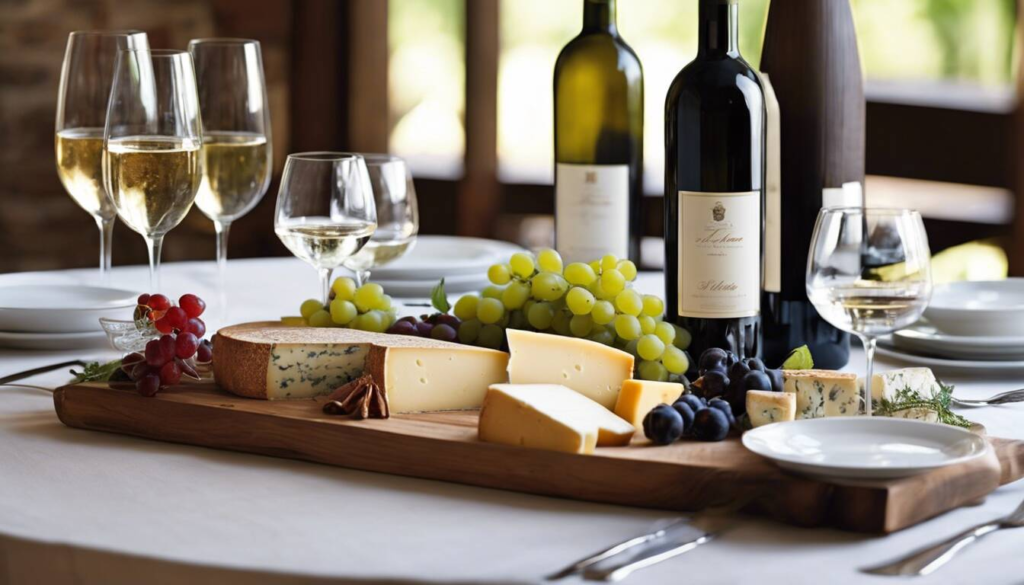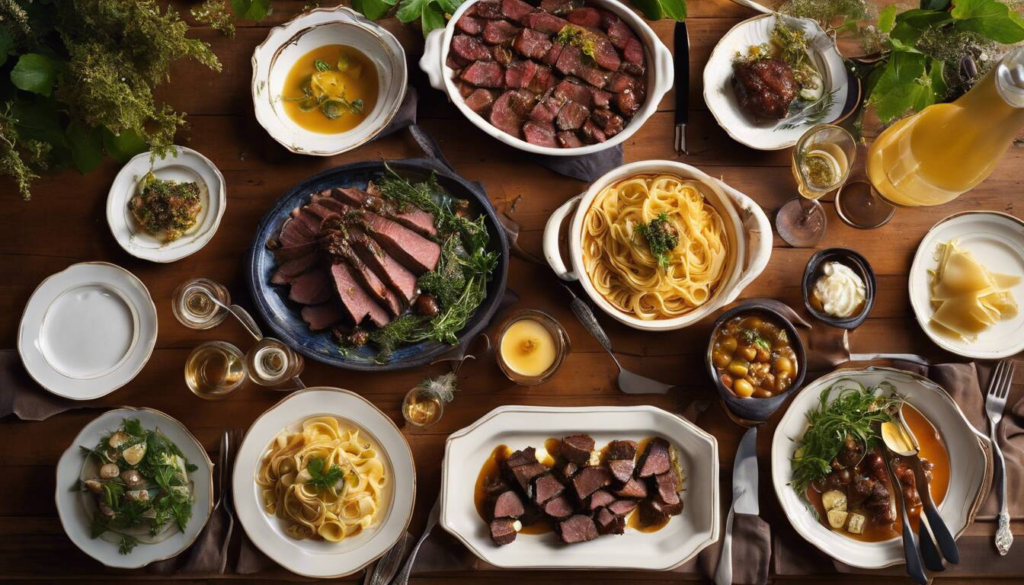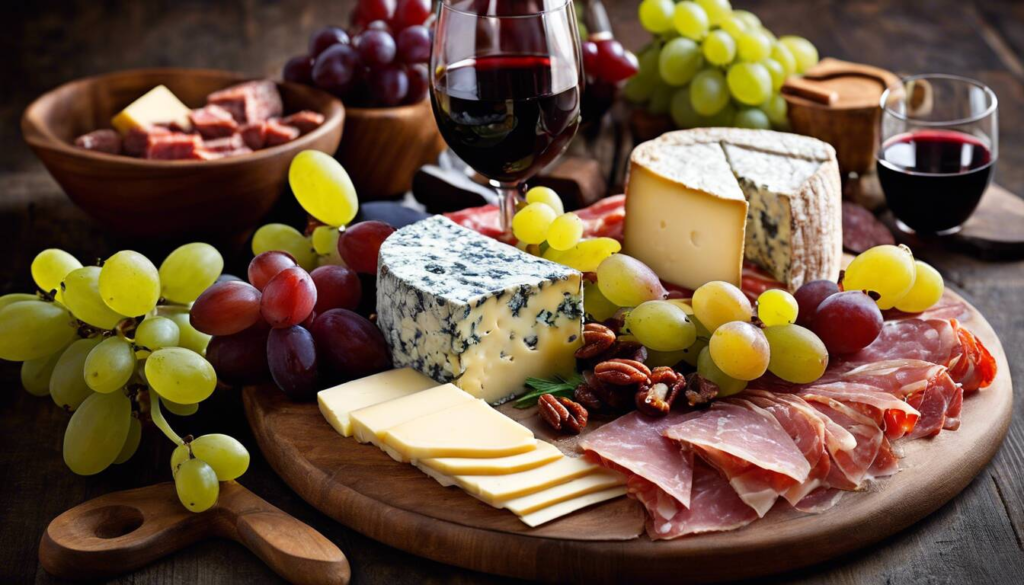Piedmont wines, both white and red, offer a versatile spectrum of flavors that pair flawlessly with a variety of dishes. For instance, the floral and elegant notes of white wines like Arneis complement seafood and light pasta dishes harmoniously, including an unexpected veal dished coated in a tuna-flavored sauce, known as “Vitello Tonnato”. On the opposite end, Piedmont’s robust reds like Barolo and Barbaresco find their perfect mates in hearty meals; braised meats and game, even with a rich truffle risotto, bring out these wines’ unique character. Now imagine pairing a Barolo with “Brasato al Barolo,” a pot roast cooked in its own wine! Next, let’s delve into the whites…
One recommended food pairing with Piedmont’s Nebbiolo-based wines is herb-roasted rack of lamb with taggiasche olive tapenade and vegetables. This dish pairs exceptionally well with Barbaresco “Mai Piu” Barbaresco Riserva 2011 from Giuseppe Nada. Additionally, Tajarìn with local saffron & zucchini, a traditional pasta dish in Langhe, can be paired with a refreshing and fruity Arneis from Roero such as Bric Cenciurio or Paitin.

Piedmont White Wine: Perfect Food Pairings
Piedmont offers a delightful selection of crisp and refreshing white wines, such as Arneis and Cortese, that make superb companions to an array of dishes. Let’s take a closer look at how these wines pair beautifully with various culinary delights.
Arneis: This aromatic white wine, with its floral and elegant notes, is a fantastic match for seafood, light pasta dishes, and fresh vegetable-based meals. The delicate flavors of Arneis complement a classic dish like “Vitello Tonnato,” where the richness of veal is balanced with a tuna-flavored sauce.
Cortese: On the other hand, Cortese shines when paired with delicate risotto or grilled fish. The light acidity of this white wine pairs perfectly with the creamy texture of a well-prepared risotto, enhancing each bite. When served alongside grilled fish, the clean and crisp profile of Cortese accentuates the natural flavors of the seafood.
Given their distinct characteristics, both Arneis and Cortese offer unique flavor combinations that enhance the overall culinary experience when thoughtfully paired with food items that complement their profiles. These food and wine pairings are more than mere combinations – they are opportunities to create memorable and harmonious dining experiences.
With these exquisite details in mind, let’s now explore the alluring world of Piedmont red wines and their perfect partners in gastronomic indulgence.
Piedmont Red Wine: Ideal Companions in Meals
The robust flavors of famed Piedmont red wines, such as Barolo and Barbaresco, call for companions that match their depth and complexity. These wines shine brightest when paired with hearty dishes featuring rich, earthy flavors. Imagine a cozy evening, sipping a glass of Barolo alongside a dish exuding warmth and depth.
One of the most beloved matches for these bold reds is truffle risotto. The deep, earthy aroma of truffles complements the intense flavors of Barolo and Barbaresco. Their taste profiles intertwine like old friends at a dinner party, creating an experience greater than the sum of its parts.
Truffle risotto is more than just a dish; it’s an indulgence steeped in tradition and elegance.
Another fantastic accompaniment to these red wines is braised meats. The tender, slow-cooked textures of beef or lamb perfectly complement the tannins and rich fruitiness found in Piedmont’s red treasures.
For those seeking authenticity, the traditional Northern Italian dish “Brasato al Barolo” showcases how well these wines pair with hearty fare. This flavorful pot roast is bathed in Barolo wine, infusing every bite with the robust essence of the region’s flagship wine.
When it comes to game dishes, these reds take center stage once again. Whether it’s a savory game stew or a succulent roasted bird, the full-bodied nature of Barolo and Barbaresco effortlessly stands up to the bold flavors of game meat, creating a harmonious symphony on the palate.
The key takeaway here is that Piedmont’s revered red wines deserve equally grand partners on the plate. It’s all about finding balance between the concentrated, luxurious notes in each bottle and the bold, elegant flavors on your dinner table.
Cheese: A Classic Partner for Piedmont Wine
Cheese: A Classic Partner for Piedmont Wine
When it comes to pairing cheese with wine, the options are as diverse as they are delightful. In the case of Piedmont wines, the creamy, rich textures of regional favorites like Castelmagno, Toma, or Robiola complement the tannins in red wines and the acidity in white wines, creating a delightful tasting experience that brings out the best in both the cheese and the wine.
The key to a successful cheese and wine pairing is discovering flavors that harmonize. This is where the unique characteristics of Piedmont cheeses come into play. Castelmagno, a semi-hard cow’s milk cheese with a wonderfully complex flavor, pairs well with robust red wines like Barolo or Barbera. On the other hand, Toma, a soft to semi-hard cow’s milk cheese with a mild yet nutty profile, complements medium-bodied reds such as Dolcetto. Meanwhile, Robiola, a soft-ripened cheese made from a mix of cow, goat, and sheep’s milk, is an ideal match for Piedmont’s white wines like Arneis or Gavi.
Expert Pairing Recommendations
| Cheese Type | Recommended Wine Pairings |
|---|---|
| Castelmagno | Barolo or Barbera |
| Toma | Dolcetto |
| Robiola | Arneis or Gavi |
Picture yourself enjoying a luscious piece of creamy Robiola alongside a crisp glass of Arneis. The creamy texture of the cheese contrasts beautifully with the vibrant acidity of the wine, creating a harmonious balance on your palate.
Overall, the marriage between Piedmont cheeses and wines isn’t just about finding any old pairing—it’s about creating an experience that highlights the unique qualities of both the cheese and wine. By exploring these regional specialties and their ideal wine companions, you’re embarking on a journey that celebrates the rich culinary traditions of Piedmont and uncovers new dimensions of flavor along the way.
With each bite and sip, you’ll discover how certain combinations can evoke contrasting sensations or entirely new flavor profiles – providing an experiential wealth worthy of exploration for any aspiring wine enthusiast.
In crafting these exquisite pairings of food and wine, one truly immerses in an age-old tradition that encapsulates not just flavors but heritage and culture. Now, let’s unfold the artistry behind blending flavors with Piedmont wines.
The Art of Blending Flavours with Piedmont Wines
Piedmont wines are a celebration of the local environment and a display of craftsmanship and flavor. For an authentic experience, consider pairing these wines with dishes that showcase the region’s bountiful produce, such as truffles, porcini mushrooms, and hazelnuts. These locally-sourced ingredients not only complement but elevate the flavors of Piedmont wines, creating a dining experience that captures the essence of the region.
Let’s take the illustrious Nebbiolo wine, for example. Its bold and complex profile makes it a perfect companion for dishes rich in earthy flavors, like a creamy truffle risotto. The depth and structure of Nebbiolo resonate with the aromatic notes of truffles, resulting in a harmonious blend that captivates the senses.
Nebbiolo’s robust nature pairs exceptionally well with dishes featuring rich flavors and textures, making it an ideal match for hearty, umami-laden dishes.
Similarly, when you introduce porcini mushrooms into the mix, consider preparing a decadent beef stroganoff—its umami-rich sauce complementing the bold tannins and fruity undertones of a Piedmontese Barbera. This marriage of flavors creates a delightful balance and contrast, enhancing both the dish and the wine.
The natural sweetness and nutty nuances of hazelnuts can also add depth to the tasting experience when incorporated into desserts like hazelnut cake. Pair this dessert with a Moscato d’Asti wine to elevate its delicate flavors and yield a satisfying conclusion to your culinary journey.
Incorporating local ingredients into your dishes pays homage to the rich culinary heritage of Piedmont and unlocks new dimensions of flavor when paired with its exquisite wines.
Moving from blending flavors to understanding complementary pairings, let’s now explore helpful tips for matching fruity and fragrant Piedmont wines with delectable dishes.
Pairing Tips for Fruity & Fragrant Piedmont Wines
When thinking about fruity and aromatic Piedmont wines like Dolcetto or Barbera, it’s easy to imagine a world of delectable food pairings. These wines have the ability to uplift the dining experience by creating harmonious flavor combinations. Let’s explore some key pairing tips that will elevate your culinary adventures and make that bottle of Piedmont wine truly shine at the dinner table.
Pairing with Fruity Wines
Fruity Piedmont wines such as Dolcetto are known for their rich fruit flavors, making them highly versatile when it comes to food pairings. Some delectable options include:
- White Truffle Risotto
- Braised Veal
- Roasted Duck
- Soft Cheeses
These pairings are designed to highlight the luscious fruitiness of Dolcetto while creating an enjoyable synergy between the wine and the cuisine.
Pairing with Fragrant Wines
Fragrant Piedmont wines like Barbera offer a unique blend of robustness and aromatics. To make the most of these delightful wines, consider these tantalizing food pairings:
- Hearty Pasta Bolognese
- Margherita Pizza
With fragrant Piedmont wines, the goal is to find dishes that celebrate their boldness while maintaining a well-balanced marriage of flavors.
By experimenting with these pairings, you have the opportunity to unlock the full potential of fruity and fragrant Piedmont wines, enriching your dining experiences with remarkable flavor combinations that delight the senses.
Now, as we’ve uncovered the perfect harmony between fruity and fragrant Piedmont wines and delectable culinary delights, let’s take a closer look at how regional dishes unite in a love affair with Piedmont wines.
Piedmont Wines and Regional Dishes: A Love Story

The regional dishes of Piedmont, Italy, share a profound bond with the area’s rich tradition of winemaking. Nestled in the charming hills and valleys of Piedmont lie vineyards producing world-class wines such as Nebbiolo, Barbera, Dolcetto, Arneis, and more – each contributing unique flavors that are meticulously selected and artfully paired with local culinary treasures.
The nurturing misty climate of the Langhe region yields an abundance of fresh truffles—a prized delicacy that finds its way into many signature Piedmontese dishes. One of the legendary traditional pairings is earthy Barolo drenched Ravioli al Plin served alongside a glass of bold and robust Barolo wine. The dish’s deep umami flavors harmonize perfectly with the robust tannins and complex aromas of the wine.
The lush landscape also puts forth an array of game meats, including rabbit, venison, and wild boar. These meats form the heart of agnolotti del plin—a small, folded pasta similar to ravioli. Paired with a Dolcetto d’Alba, this dish takes on a new life as the bright acidity of the wine complements the savory and hearty flavors.
Culinary Traditions & Wine Harmony
Piedmont’s rich culinary traditions are heavily anchored in influences from its French neighbors across the Alps. In fact, the region even shares a love for tajarin—a delicate pasta very similar to tagliatelle. When paired with a glass of medium-bodied Roero Arneis or Gavi di Gavi, its light citrus notes bring out the freshness of dishes like Tajarìn with local saffron & zucchini.
The hearty cuisine that characterizes Piedmont is complemented beautifully by its robust red wines like Barbaresco or Barolo. For instance, Brasato al Barolo (Barolo beef stew) is an all-time favorite comfort food in the region. The succulent beef braised in fragrant spices soaked in a velvety Barolo creates an irresistible combination.
Similarly, another classic pairing includes Finanziera (a traditional offal dish) with a glass of Nebbiolo d’Alba. The complex flavors of Nebbiolo stand up to the rich and savory elements found in many Piedmontese regional foods, making it an ideal complement to heavy and robust meat dishes.
We’ve only just scratched the surface of these delightful food and wine combinations. Let’s explore even more enchanting pairings that capture the true essence of Piedmont’s culinary heritage.
In conclusion, exploring the perfect fusion of Piedmont wines with regional culinary delights can truly elevate your dining experience to new heights.
